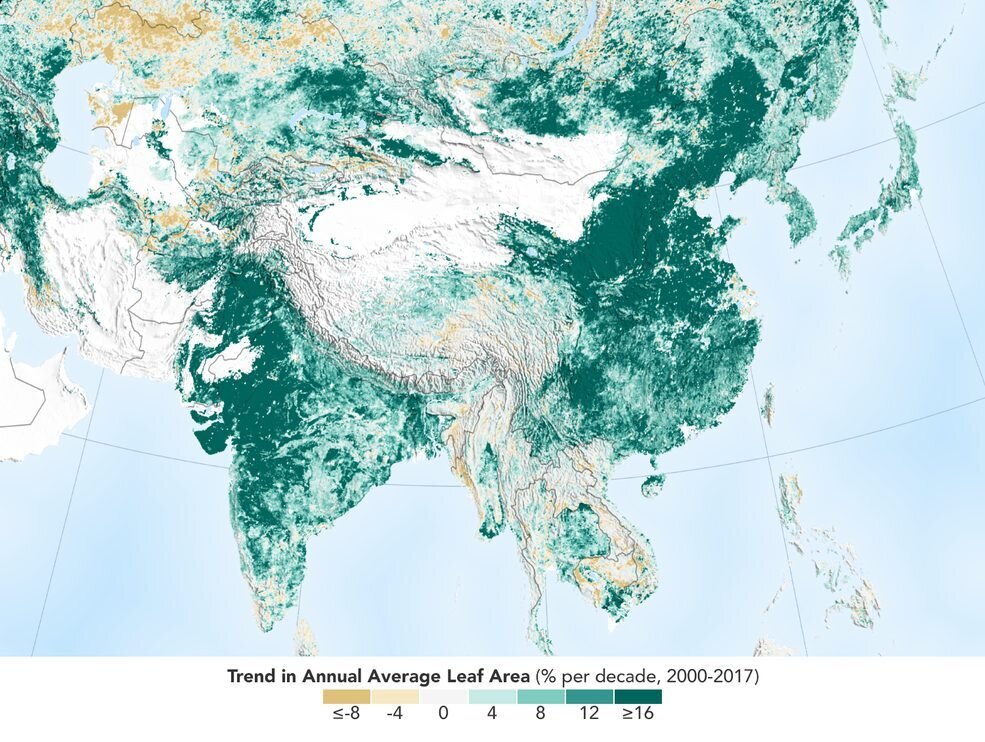by Papillon
Today on Facebook I came across an article celebrating the fact that NASA has found that the earth has greened up over the past 20 years thanks to massive tree planting in China and India.
Surely not, I thought. So I googled the phrase “NASA says world greener” and found a slew of articles published over the past 24 hours all trumpeting the news. The first 20 or so all had variations on the same headline praising China and India’s tree planting. So it must be true, right?
Unfortunately no. This is a really good example of bad science reporting, spin and “greenwashing”.

Regrettably, even the NASA web page about the research - which was NOT conducted by NASA at all but merely used publicly available data from NASA’s satellites - is highly misleading. And it’s all in the spin. When you talk about “China and India leading the increase” and China’s “ambitious tree planting programs” as in NASA’s caption above, you can certainly see where the commonly reported headline comes from. While the NASA article isn’t technically incorrect, the wording is very misleading. Unless you have been trained to focus on the precise meaning of every single word (as scientists like me have), you are simply not going to pick it up. But it’s spin. Fake news. Greenwash. Given an aura of legitimacy by the NASA badge.
YES, it’s true, there have been massive tree plantings in China and, to a lesser extent, India. And we should certainly be happy about that.
And YES, scientist Chi Chen and colleagues from Boston University in Massachusetts are reporting a 5% increase in average total leaf area across the entire planet over the period 2000-2017.
But tree plantings in China and India are NOT chiefly responsible for the increase in planetary greenness. What the headline should probably have said is what the scientists actually reported in their paper, namely
“Earth is 5% greener since 2000 due to the Greenhouse Effect”.
But that’s not quite as sexy, is it. Nor is it good news. In fact it’s quite the opposite.
What Chi Chen and colleagues actually found (as reported in Nature Sustainability volume 2, pages 122–129 (2019)) was:
- the earth’s Greenness Index (something detected by sensors on NASA’s MODIS satellites) has increased over the period 2000-2017 and this equates to a 5% increase in annual average total leaf area across the entire planet
- over the period 2000-2017 the total surface area covered by leaves in the planet’s vegetated zones has grown. The increase is spread out across the world but if put together would be roughly equal in size to the Amazon rainforest.
- in addition to this, about 30% of land that was already green in 2000 is even greener now and about 5% is less green now
- the “dominant drivers” of this overall increase in greenness are “climate change and CO2 fertilization effects”. In other words - the Greenhouse Effect. These indirect effects of human activity account for 70% of the increased greenness across the planet.
- the remaining 30% is due to direct effects of human activity and this is concentrated in China and India
- in China:
- 42% of the increase in greenness is due to large scale tree plantings.
- 32% of the increase in greenness is due to agricultural intensification (that is, greater use of irrigation, fertiliser (particularly Nitrogen), pesticides and fossil fuels.)
- in India:
- only 4% of the increase is due to large scale tree plantings.
- and fully 82% of the increase is due to agricultural intensification.

Now, if you’ve made it this far through the article and all that accurate science reporting hasn’t put you to sleep, you’ll see that this tree story isn’t half as green as it seemed. Indeed its only 42% of 25% of 5% as green as it seemed. It’s precisely 0.525% as green as it seemed.
So the great news about the tree plantings in China (and it really IS great news) is sadly only the thin silver lining on an otherwise dark cloud of climate change and ‘business-as-usual’ industrial agriculture.
Am I disappointed the world isn’t 5% greener due to tree plantings? Yes, I am. But I am much more disappointed that the research has not been reported honestly by a respected scientific institution, and that literally dozens of news services that trust that institution are now promulgating the spin, fake news, and greenwash of its story. Why would the Ames Research Center spin the story this way? Who knows. Maybe it’s just a staffer in their communications department with a particularly optimistic disposition, who lacks the skills to actually read the original article properly. Maybe it goes much deeper than this and comes down to political influence. But regardless of where it sits on the spectrum, from inept to devious, it stinks!
If, like me, harsh realities like this tend to make you sad, angry and perhaps despairing, let me encourage you to take that energy and invest it in a positive way. Do what you can - everything you can - to stop being part of the problem and, as much as is within your power, every day strive to be part of the solution.
The original scientific publication is here:
https://www.nature.com/articles/s41893-019-0220-7
NASA’s post is here: